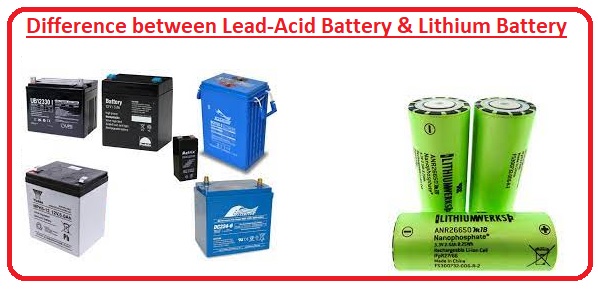 Hi guys in this post we will discuss the Difference between Lead-Acid Battery & Lithium batteries. Why we choose a lithium-ion battery in place of a single lead acid battery? It is a very commonly asked question. Everyone select the lithium-ion batteries due to their advantages. Here we have discussed all advantages So let’s get started Difference between Lead-Acid Battery & Lithium Battery
Hi guys in this post we will discuss the Difference between Lead-Acid Battery & Lithium batteries. Why we choose a lithium-ion battery in place of a single lead acid battery? It is a very commonly asked question. Everyone select the lithium-ion batteries due to their advantages. Here we have discussed all advantages So let’s get started Difference between Lead-Acid Battery & Lithium Battery
Charge the battery
The lead charge of lead-acid batteries is very low, which is only 70%. In other words, these battery packs lose a lot of rechargeable power. A lot of energy is burned to mix the acid. This process raises the temperature of the battery and causes internal water to evaporate. For this, you need to get out of the unit with regular refined water.
While it is not easy to recharge lithium-ion batteries fully. So these elements can assist us to reduce the amount used for electrical bills. The reason is that these products are 96% effective. Also, they can accept faster and slower charging without any problem.
Battery Weight
The weight of lithium batteries is about three times then lead acid. It is the cause to move easily.We can easily move these batteries from one point to other without use of hand
Nutrition
Lead-acid batteries require a lot of care. Repairing at regular intervals is not easy to process.. You must raise the water, maintain the filling process and eliminate oxide from terminals and nutrients.
Therefore, these are three hidden costs in terms of maintenance. First, acid batteries emit large amounts of gas during recycling. Therefore, so must not place them in your living room. You must provide a separate space for these units.
The gas released by these components must be expelled from the charging area. Therefore, you need to install a special ventilation system for this purpose.
For small companies, the cost of over-watering can be a typical cost. It is not a condition for small-level businesses and can be expensive. While we do not need to pay any structure expenses for lithium-ion batteries.
Service Life
The operating life of Lithium-ion batteries is 3 times larger them another. So they can save money for a longer duration
Air Safety and Exhaust
In terms of safety, lead-acid batteries contain safety systems. They do not shut off and release hydrogen during recycling. It is the reason they’re used in food industry
In contrast, lithium batteries do not emit harmful gases. So the can e a good option for different applications They also have special control systems designed for extra protection.
Lead-Acid Battery vs Lithium Battery
| Feature | Lead-Acid Battery | Lithium Battery |
|---|---|---|
| Composition | Lead plates, sulfuric acid electrolyte | Lithium-ion, lithium polymer |
| Energy Density | Low | High |
| Weight | Heavy | Lightweight |
| Charging Time | Slow | Fast |
| Self-Discharge Rate | High | Low |
| Maintenance | Requires regular maintenance | Low maintenance |
| Lifetime | Shorter lifespan | Longer lifespan |
| Cost | Low initial cost | High initial cost |
| Safety | Potentially hazardous, can leak acid | Generally safe, but can catch fire if punctured or overheated |
Which is better lead-acid battery or lithium-ion battery?
The dependability and efficiency enhance its option use in place of lead-acid
What is the advantage of a lead-acid battery over lithium?
- Though lead acid batteries are less costly provide small operating life and need ongoing maintenance to work accurately
What lasts longer lithium or lead-acid battery?
. The life span of lithium-ion battery is about three to four times larger
Can I just replace lead-acid battery with lithium?
Lithium-ion batteries are high-performance energy storage options that can be readily swapped without all the drawbacks, making them a perfect alternative for replacing and upgrading worn-out lead acid batteries even though lead-acid batteries are well-known as workhorses.
What are the disadvantages of lithium-ion batteries?
Lithium-ion has disadvantages despite overall benefits. It is delicate and needs a protection circuit to continue operating safely. The safety circuit, which is included into each pack, controls the peak voltage that each cell may reach while charging and prevents the cell voltage from falling too low during discharge.






